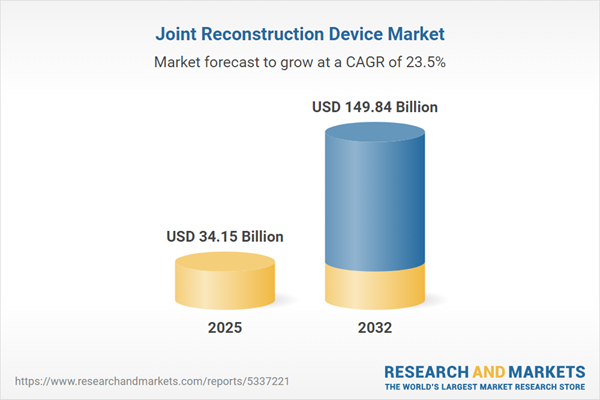Speak directly to the analyst to clarify any post sales queries you may have.
The joint reconstruction device market is undergoing rapid change as healthcare providers seek innovative solutions to optimize surgical outcomes and manage operational pressures. Evolving clinical demands, regulatory shifts, and supply chain strategies are reshaping competitive dynamics for organizations operating in this sector.
Market Snapshot: Joint Reconstruction Device Market Growth and Trends
The global joint reconstruction device market reached USD 27.75 billion in 2024 and is forecasted to increase to USD 34.15 billion in 2025, with a compound annual growth rate of 23.46 percent through 2032. Market expansion is strongly influenced by the global aging population and a higher incidence of musculoskeletal disorders. Healthcare providers are shifting toward minimally invasive joint reconstruction devices and integrating digital technologies to improve both patient care and operational agility. Manufacturers are responding by refining product portfolios, enhancing clinical efficiencies, and collaborating more closely with care networks to stay resilient in a dynamic landscape.
Scope & Segmentation of the Joint Reconstruction Device Market
- Applications: Joint reconstruction devices are essential in knee, hip, shoulder, and spine procedures, covering both partial and total surgical interventions. The development of reverse and unicompartmental approaches allows clinics to address a broader range of anatomical needs and patient cases.
- Product Types: Solutions include 3D printed implants, polymer-based devices, tissue-engineered scaffolds, and modular systems. Precision surgical instruments further streamline workflows and support consistent procedural results.
- Materials: The use of high-performance biomaterials such as cobalt chrome, titanium, PEEK, stainless steel, and UHMWPE is central to extending implant durability and advancing more tailored treatment options for patients.
- End Users: Core segments span hospitals, orthopedic clinics, ambulatory surgical centers, and specialized medical facilities, all of which value clinical effectiveness, adaptable device integration, and workflow enhancements based on their unique operational needs.
- Regions: The market encompasses North America, Europe, Latin America, Middle East & Africa, and Asia-Pacific. Established regions like the United States and Germany are at the forefront of adopting advanced solutions, while emerging economies such as China, India, Saudi Arabia, and South Africa provide important growth opportunities as healthcare investments and reimbursement models evolve.
- Leading Companies: Key participants including Johnson & Johnson, Zimmer Biomet Holdings, Stryker Corporation, Smith & Nephew, Exactech, MicroPort Scientific Corporation, Corin Group, DJO Global, CONMED, and LimaCorporate continue to set the pace for product innovation and industry collaboration.
Key Takeaways for Senior Decision-Makers
- Technological advancements in joint reconstruction devices simplify complex procedures and enhance clinical results, aligning with institutional priorities for quality care and service expansion.
- Customizable biomaterials support precision medicine and value-based care initiatives, enabling organizations to address a wider spectrum of patient needs with improved efficiency.
- Minimally invasive device designs reduce patient risk and accelerate recovery, which strengthens clinical outcomes and upholds rising care standards across healthcare facilities.
- Strategic partnerships between device manufacturers and clinicians are shortening innovation cycles and enabling faster market introduction of specialized tools.
- Flexible adaptation to payer guidelines and regulatory developments ensures financial resilience and prepares organizations for fluctuations in reimbursement criteria.
- Growing investments in healthcare infrastructure in emerging markets are increasing access to advanced joint reconstruction technology and sharpening global competition.
Tariff Impact: US Policy and Supply Chain Adaptation
Recent changes in US tariff policy have led joint reconstruction device manufacturers to prioritize local production and strengthen supplier relationships. These adjustments help limit regulatory risks, sustain operational continuity, and promote bundled service contracts that address the evolving demands of the policy environment.
Methodology & Data Sources
Findings are based on a review of peer-reviewed publications, regulatory filings, clinical studies, and quantitative market data. The insights incorporate expert perspectives from surgical practice, procurement, and medical device integration to ensure relevance and accuracy.
Why This Report Matters for B2B Decision-Makers
- Delivers actionable guidance on joint reconstruction device technologies, aiding risk-mitigation strategies and supporting forward-looking procurement decisions.
- Helps benchmark commercial strategies and research initiatives to strengthen decision-making for partnerships, innovation, and business transformation.
- Equips organizations to align supply chain processes with new clinical demands and reimbursement policies within a specialized and evolving medical device sector.
Conclusion: Strategic Focus for Sustainable Market Growth
Prioritizing innovation, supply chain resilience, and adaptive regional strategies supports improved care delivery and sustainable advancement within the joint reconstruction device market.
Additional Product Information:
- Purchase of this report includes 1 year online access with quarterly updates.
- This report can be updated on request. Please contact our Customer Experience team using the Ask a Question widget on our website.
Table of Contents
3. Executive Summary
4. Market Overview
7. Cumulative Impact of Artificial Intelligence 2025
Companies Mentioned
The companies profiled in this Joint Reconstruction Device market report include:- Johnson & Johnson
- Zimmer Biomet Holdings, Inc.
- Stryker Corporation
- Smith & Nephew plc
- Exactech, Inc.
- MicroPort Scientific Corporation
- Corin Group Limited
- DJO Global, LLC
- CONMED Corporation
- LimaCorporate S.p.A
Table Information
| Report Attribute | Details |
|---|---|
| No. of Pages | 185 |
| Published | October 2025 |
| Forecast Period | 2025 - 2032 |
| Estimated Market Value ( USD | $ 34.15 Billion |
| Forecasted Market Value ( USD | $ 149.84 Billion |
| Compound Annual Growth Rate | 23.4% |
| Regions Covered | Global |
| No. of Companies Mentioned | 11 |









